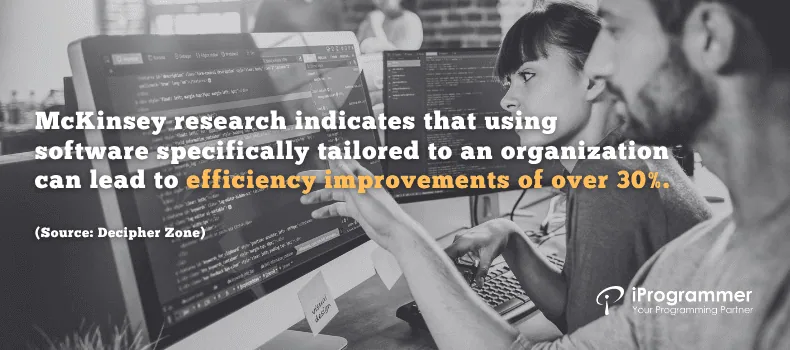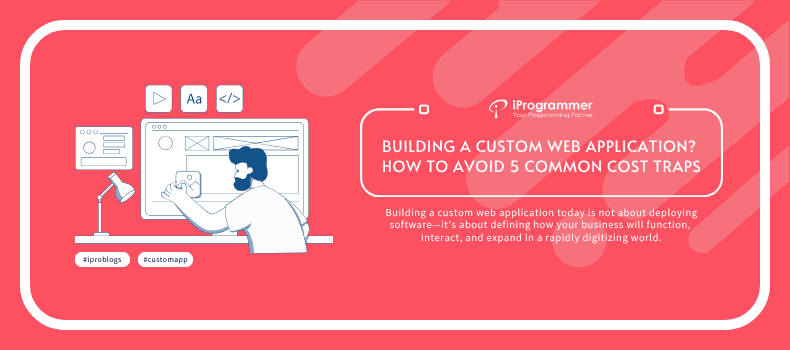Building a Custom Web Application? How to Avoid 5 Common Cost Traps
Building a custom web application today is not about deploying software—it’s about defining how your business will function, interact, and expand in a rapidly digitizing world. For founders and product managers, this process often starts with vision and purpose. But as schedules grow longer and budgets shrink, even the most carefully laid plans can fall apart.
What gets lost in the shuffle isn’t technical expertise—it’s cost sensitivity. Not just budgets, but the way initial choices have cost ripple effects down the road. The silver lining? Most budget overruns are not unforeseen. They play out along consistent patterns, which makes them predictable—and preventable—with advance vision. In this blog, we will learn why businesses are turning towards custom web application development, five pitfalls that sabotage web application budgets, and insights on how to build smarter from the beginning.
Why Custom Web Application Development
The choice between custom and off-the-shelf software is about control. Pre-packaged platforms can get you started quickly, but they often force teams to adjust their processes to fit the product. For businesses with unique workflows, evolving priorities, or a need to differentiate, that trade-off becomes restrictive fast.
Custom development, by contrast, offers the flexibility to design around your business—not the other way around. You define the roadmap, the architecture, and the user experience. It gives you the space to build software that aligns with how your product or team truly operates.
For many early-stage teams, adaptability is more important than features. The market evolves, user needs shift, and the product often changes shape within the first 12–18 months. Custom applications are better suited to navigate that change.
You’re not waiting on feature releases from a vendor or negotiating limitations with external platforms. Instead, your product can evolve in real time—with architecture that supports iteration, not resists it.
This becomes especially important when feedback loops are short and fast—when each release builds on what you’ve learned, and roadmaps are in motion.
The strength of a custom build lies not just in flexibility, but in how tightly it can align with your business goals. Every part of the application—from logic to interface to integrations—can reflect your product vision.
That alignment is hard to achieve with general-purpose tools. You end up adapting, extending, or working around them. And over time, that compromises both experience and efficiency.
A custom solution lets you embed your process into the product—creating a more seamless connection between how the business operates and how the software performs.
Custom software isn’t inexpensive upfront—but it can be far more cost-efficient over time. Off-the-shelf tools often come with hidden costs: rising subscription fees, data limitations, forced upgrades, and integration complexity.
With a custom application, you’re investing in a product that belongs to you. The roadmap is yours to set. The stack is yours to evolve. There’s no vendor agenda—just a build that grows as your needs do.
When done thoughtfully, it becomes a long-term asset—not a recurring liability.
Still, flexibility alone doesn’t guarantee value. In fact, custom development introduces a different kind of risk: the quality of execution. Without clear priorities, aligned teams, and the right checks in place, it’s easy to overbuild, overspend, or miss the mark entirely.
And that’s where most budget overruns begin—not with the decision to go custom, but with how that decision is handled.
It’s easy to rush, particularly when the vision is clear and the opportunity in the market feels pressing. But vision-level clarity doesn’t necessarily carry over into execution. Without a defined discovery process, teams will charge in half-informed assumptions, unclear technical boundaries, and minimal knowledge of the users they’re creating for.
The actual cost isn’t confusion alone—it’s the rework that follows. Features are created and abandoned. Priorities change mid-project. And what appeared to be progress becomes technical debt. A good discovery phase does more than chart requirements—it validates assumptions, exposes gaps, and creates internal alignment.
It’s common to hear phrases like “we want to build it to scale,” or “let’s make it future proof.” The intent is valid. But in practice, many early-stage applications overcomplicate architecture well before there’s user traffic to justify it. Auto-scaling, microservices, distributed databases— these may be essential later, but in the beginning, they create: more dev time, more cost, more moving parts to debug.
Building for scale prior to scaling is like building a bridge to support freight trucks when you’re only anticipating bicycles. It may seem impressive—but it slows you down needlessly. The better approach? Create with a well-defined path for upgrade. Make the architecture lean, but extensible. Save complexity for when the business requires it—necessarily, not optionally.
API integrations often appear straightforward on paper. “Connect to the CRM,” “sync with the ERP,” “pull data from this third-party service.” But integrations bring their own ecosystem of challenges. API integrations tend to look easy on the paper. “Integrate with the CRM,” “sync with the ERP,” “pull from this third-party provider.” But integrations have their own universe of difficulties.
Vendor-side issues—like throttling limits, inconsistent documentation, or breaking changes—can halt progress. Internal systems, particularly legacy ones, may not be built for seamless data exchange. And every “simple sync” need testing, error handling, retries, and monitoring. Most teams don’t ignore integrations—they simply underestimate the nuance involved. And by the time it becomes clear, it’s already affecting deadlines and budgets.
In many projects, testing is compressed toward the end—when timelines are tight, energy is low, and pressure is high. The result is predictable: late discovery of problems, missed edge cases, and solutions that involve going backward in the development cycle.
What’s often missed is that QA is not only code validation—it’s assurance of experience. Each bug that makes it through affects user trust. Each flow that breaks add friction. More importantly, problems caught early cost exponentially less to resolve. A design or requirement clarity bug can cost a fraction of the same bug in production.
Product strategy shifts. Roadmaps adjust. But when dev teams are isolated from these changes, the outcome is functionality that functions—but no longer resonates. This misalignment isn’t instantaneous. It begins quietly: a sprint scheduled on stale priorities, a feature created ahead of user input being filtered, or a business stakeholder thinking the tech team is “already on it.”
Eventually, the product drifts —functionally strong, but strategically off-course. The solution isn’t more meetings. It’s tighter feedback loops, shared ownership, and a cadence where business context is continuously translated into development focus.

Every custom application involves unknowns—but not every unknown should turn into a cost overrun. The most capable teams don’t just track budgets; they shape them through better decision-making. They plan deliberately, align continuously, and stay grounded in the realities of what the business truly needs. In the end, successful custom applications aren’t rushed—they’re thoughtfully built. And that kind of outcome depends not just on technology, but on who you choose to build with.
Since 2007, iProgrammer has worked closely with startups and enterprises to turn complex ideas into well-built, cost-aware software. Our approach is grounded in clarity, not shortcuts. From early discovery to long-term evolution, we emphasize alignment—between business goals, technical decisions, and product realities. Whether you’re starting fresh or looking to recalibrate an existing project, we bring the experience to help you build with confidence.









